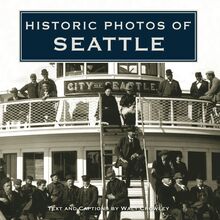Historic Photos of Minnesota , livre ebook
191
pages
English
Ebooks
2009
Vous pourrez modifier la taille du texte de cet ouvrage
Obtenez un accès à la bibliothèque pour le consulter en ligne En savoir plus
Découvre YouScribe en t'inscrivant gratuitement
Découvre YouScribe en t'inscrivant gratuitement
191
pages
English
Ebooks
2009
Vous pourrez modifier la taille du texte de cet ouvrage
Obtenez un accès à la bibliothèque pour le consulter en ligne En savoir plus
Publié par
Date de parution
01 juin 2009
Nombre de lectures
0
EAN13
9781618584069
Langue
English
Poids de l'ouvrage
8 Mo
Minnesota’s past is defined by its remarkable natural resources, and shaped by its native peoples and early settlers. From the fur trade and the establishment of Fort Snelling, to harnessing the power of the Mississippi River as a means to fuel emergent logging and milling industries, Minnesota’s history is that of a land like no other.
Pioneering Minnesotans embraced everything that the sprawling prairies, rich farmlands, and more than 10,000 lakes offered. Boomtowns and small towns sprang up and were connected to the thriving metropolises of Minneapolis and St. Paul through a great labyrinth of railways.
From the time photographers first started pointing their cameras in the direction of Minnesota’s land and people, crystallized moments from the state’s history were captured, and stories preserved.
The archival images collected in Historic Photos of Minnesota offer unique insights into the state’s not-so-distant past. Spanning more than 100 years, this book documents everyday lives and significant events in Minnesota’s extraordinary history.
Publié par
Date de parution
01 juin 2009
Nombre de lectures
0
EAN13
9781618584069
Langue
English
Poids de l'ouvrage
8 Mo
HISTORIC PHOTOS OF
MINNESOTA
T EXT AND C APTIONS BY S USAN M ARKS
A panoramic view of the 1870 pioneer town of Duluth, facing Lake Superior. Duluth first gained nationwide attention in the 1850s when rumors of copper-rich land began to circulate. Many sought their fortune in Duluth, sparking a land rush in the area. There was little actual copper, however, and pioneer interest soon turned toward iron ore mining, railroads, and shipping.
HISTORIC PHOTOS OF
MINNESOTA
Turner Publishing Company
200 4th Avenue North Suite 950
Nashville, Tennessee 37219
(615) 255-2665
www.turnerpublishing.com
Historic Photos of Minnesota
Copyright 2009 Turner Publishing Company
All rights reserved.
This book or any part thereof may not be reproduced or transmitted in any form or by any means, electronic or mechanical, including photocopying, recording, or by any information storage and retrieval system, without permission in writing from the publisher.
Library of Congress Control Number: 2008910975
ISBN-13: 978-1-59652-523-8
Printed in China
09 10 11 12 13 14 15-0 9 8 7 6 5 4 3 2 1
C ONTENTS
A CKNOWLEDGMENTS
P REFACE
M INNESOTA ON THE M AP (1850-1899)
T HE T HREE F RONTIERS (1900-1909)
T RANSFORMATION (1910-1929)
D EPRESSION AND W AR (1930-1945)
M ODERN M INNESOTA (1946-1969)
N OTES ON THE P HOTOGRAPHS
Visitors to Minnehaha Falls in Minneapolis, a popular tourist destination after the publication of the epic poem The Song of Hiawatha by Henry Wadsworth Longfellow in 1855. Longfellow never visited the falls, but he was inspired by the stories of Mary Eastman and Henry Rowe Schoolcraft about American Indian culture and the imagery of the falls.
A CKNOWLEDGMENTS
This volume, Historic Photos of Minnesota , is the result of the cooperation and efforts of many individuals, organizations, and corporations. It is with great thanks that we acknowledge the valuable contribution of the following for their generous support:
Library of Congress
Minnesota Historical Society
We would also like to thank the following individuals for valuable contributions and assistance in making this work possible:
Doug Bekke, Minnesota Military Museum
Jeff Forester
Carolyn Kneisl, Kandiyohi County Historical Society
Sarah LaVine, Stearns History Museum
Patricia Maus, Northeast Minnesota Historical Center
Bob Sandeen, Nicollet County Historical Society
David Stevens, the Mill City Museum, Minnesota Historical Society
Minnesota Historical Society s Library Staff
P REFACE
Minnesota has thousands of historic photographs that reside in archives, both locally and nationally. This book began with the observation that, while those photographs are of great interest to many, they are not easily accessible. During a time when Minnesota is looking ahead and evaluating its future course, many people are asking, How do we treat the past? These decisions affect every aspect of the state-architecture, public spaces, commerce, infrastructure-and these, in turn, affect the way that people live their lives. This book seeks to provide easy access to a valuable, objective look into the history of Minnesota.
The power of photographs is that they are less subjective than words in their treatment of history. Although the photographer can make decisions regarding subject matter and how to capture and present it, photographs do not provide the breadth of interpretation that text does. For this reason, they offer an original, untainted perspective that allows the viewer to interpret and observe.
This project represents countless hours of review and research. The researchers and writer have reviewed thousands of photographs in numerous archives. We greatly appreciate the generous assistance of the individuals and organizations listed in the acknowledgments of this work, without whom this project could not have been completed.
The goal in publishing this work is to provide broader access to this set of extraordinary photographs that seek to inspire, provide perspective, and evoke insight that might assist people who are responsible for determining Minnesota s future. In addition, the book seeks to preserve the past with adequate respect and reverence.
With the exception of touching up imperfections that have accrued with the passage of time and cropping where necessary, no changes have been made. The focus and clarity of many images is limited by the technology and the ability of the photographer at the time they were taken.
The work is divided into eras. Beginning with some of the earliest known photographs of Minnesota, the first section records photographs through the end of the nineteenth century. The second section spans the first decade of the twentieth century. Section Three moves from 1910 through the 1920s. Section Four covers the Great Depression and World War II years, while the last section proceeds from the end of the war to recent times.
In each of these sections we have made an effort to capture various aspects of life through our selection of photographs. People, commerce, transportation, infrastructure, religious institutions, and educational institutions have been included to provide a broad perspective.
We encourage readers to reflect as they go traveling in Minnesota, strolling through its parks and the neighborhoods of its cities, and visiting its countryside and many lakes. It is the publisher s hope that in utilizing this work, longtime residents will learn something new and that new residents will gain a perspective on where Minnesota has been, so that each can contribute to its future.
-Todd Bottorff, Publisher
On August 1, 1870, the St. Paul and Lake Superior Stagecoaches ceremoniously quit service with the opening of the Lake Superior and Mississippi Railroad. On this day, the first train arrived in Duluth from St. Paul, a roughly 150-mile trip that took 16 hours.
M INNESOTA ON THE M AP
(1850-1899)
Long before Minnesota had a name, and long before cameras could capture the land s unspoiled, majestic beauty, Europeans took notice. Tales of thundering falls, towering pines, open prairies, fresh air, and rivers and lakes teeming with fish and wildlife proved irresistible.
Early explorers and fur traders were equally awed by the native Dakota and Ojibwe people, and their deep spiritual connection to this land. In 1682, the exaggerated travel accounts published by Father Louis Hennepin inspired widespread fascination with this mystical place just waiting to be explored and conquered.
Most of the area that we now know as Minnesota opened up for settlement when acquired from France via the 1803 Louisiana Purchase. Permanent white settlement ultimately appeared in the form of Fort Snelling at the confluence of the Mississippi and Minnesota rivers. Construction of the fort began in 1819 and was completed in 1825. Soon the St. cities emerged-St. Paul, as Minnesota s capital city, and St. Anthony, at the Falls of St. Anthony. The worlds of the white settlers, fur traders, Dakotas, and Ojibwes often collided, but at times fell into harmonious rhythms.
Minnesota became a territory in 1849, and nine years later it became the 32nd state admitted to the Union. Around this same time, the west side of the Mississippi River opened up for settlement, and the city of Minneapolis was born on the other side of the Falls of St. Anthony. Minneapolis and St. Anthony eventually joined to become one city, Minneapolis.
The promise of rich farmland lured early pioneers to Minnesota. The vast forests of white pine had the same effect on lumbermen. Boomtowns and hamlets sprang up all over the state as the railroad industry increasingly became integral to Minnesota s way of life.
There was also darkness. The new state of Minnesota experienced a catastrophic blow with the U.S.-Dakota War of 1862. Relegated by treaty to small reservations along the Minnesota River, the Dakota Indians were near starvation and unable to persuade traders or the local federal agent to release stockpiled food. Desperation and tension grew as the Dakotas awaited overdue money promised by the United States government. When several young Dakota men launched a brutal attack on white settlers, a deadly war quickly erupted on Minnesota s prairies.
Early settlers pose in front of the Bierbauer Woolen Mill in Mankato sometime in the 1860s. The mill s owner, Wilhelm Bierbauer, fought in a battle against the Dakota Indians in nearby New Ulm during the U.S.-Dakota War of 1862. After the war, more than 300 Dakota men were tried for various offenses and sentenced to die. Upon review of the convictions, President Lincoln commuted the sentences of all but 38. Those 38 Dakotas were executed in a mass hanging in Mankato-the largest mass execution in U.S. history.
On August 21, 1862, white settlers sought refuge near the Upper Sioux Agency during the U.S.-Dakota War. Historians estimate that more than 500 settlers, including women and children, were killed during one of the most catastrophic episodes Minnesota has ever known. This photo, taken by refugee Adrian J. Ebell, is the only known photograph taken during the war.
The camp where captured Dakotas were incarcerated on the Minnesota River flats below Fort Snelling, following the U.S.-Dakota War. About 1,600 other Dakotas-mostly nonparticipants in the war-were forced into this camp. Approximately 130 Dakota men, women, and children died due to food poisoning, starvation, disease, and exposure.
A ferryman pulls a cable across the Mississippi River to guide the ferry to Fort Snelling in 1861. The ferryboat was owned by Franklin Steele, the pioneering lumber mill owner and former shopkeeper of the fort, who was also the first legal settler in St. Anthony.
Lumberjacks sawing a white pine in one of Minnesota s many thriving pineries around 1865. Minnesota white pine was a lumberman s dream, because it was light, buoyant for the springtime river log drives, and easy to cut in the sawmills. At the same time, th














